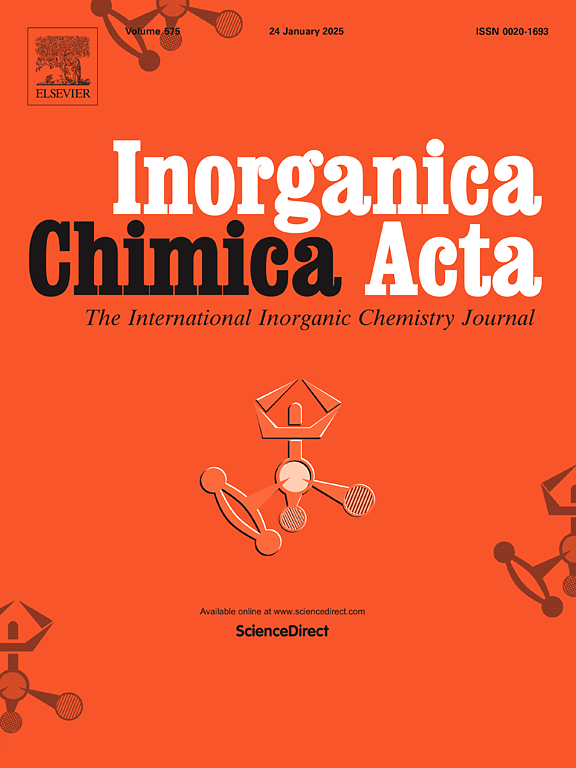Two novel viologen-based photochromic complexes with photo-regulated fluorescence, ammonia and Cr2O72− detection performance
IF 2.7
3区 化学
Q2 CHEMISTRY, INORGANIC & NUCLEAR
引用次数: 0
Abstract
Two viologen-derived complexes, {[Zn3(bcbpy)3]Cl6·8H2O}n (1) and {[Cd3(bcbpy)3]Cl6}n (2), were synthesized via solvothermal methods using 1,1′-bis-((3-carboxyphenyl)-4,4′-bipyridine) dichloride (H2bcbpy·2Cl), Zn(NO3)2·6H2O and CdCl2·2.5H2O. Structural analysis revealed that 1 adopts a double-stranded 1D chain, whereas 2 forms a wavy 1D architecture. Both complexes displayed reversible photochromism under UV irradiation, transitioning from orange/light-yellow to blue, with 2 exhibiting a faster reaction rate. The photoresponse was attributed to viologen radical formation via photoinduced electron transfer, as evidenced by electron spin resonance (ESR) and X-ray photoelectron spectroscopy (XPS). Both complexes also demonstrated fluorescence modulation under light exposure. Additionally, 1 demonstrated rapid ammonia vapor detection through electron donation from NH3 to viologen. Both complexes functioned as selective fluorescence sensors for Cr2O72−, achieving detection limits of 1.10 μM (1) and 5.87 μM (2). This study provides a strategy for designing multifunctional materials with integrated chromic and sensing properties.

两种具有光调节荧光、氨和Cr2O72−检测性能的新型紫罗兰基光致变色配合物
以1,1′-双-((3-羧基苯基)-4,4′-联吡啶)二氯(H2bcbpy·2Cl)、Zn(NO3)2·6H2O和CdCl2·2.5H2O为原料,采用溶剂热法合成了两个紫外光原衍生的配合物{[Zn3(bcbpy)3]Cl6}n(1)和{[Cd3(bcbpy)3]Cl6}n(2)。结构分析表明,1为双链一维结构,2为波浪一维结构。两种配合物在紫外照射下都表现出可逆的光致变色,从橙色/浅黄色转变为蓝色,其中2的反应速度更快。电子自旋共振(ESR)和x射线光电子能谱(XPS)证实了光响应是通过光诱导电子转移形成紫根自由基。这两种配合物在光照射下也表现出荧光调制。此外,1通过NH3给电子到viologen,证明了氨蒸汽的快速检测。这两种配合物都是Cr2O72−的选择性荧光传感器,检测限分别为1.10 μM(1)和5.87 μM(2)。本研究为设计集色敏性能于一体的多功能材料提供了一种思路。
本文章由计算机程序翻译,如有差异,请以英文原文为准。
求助全文
约1分钟内获得全文
求助全文
来源期刊

Inorganica Chimica Acta
化学-无机化学与核化学
CiteScore
6.00
自引率
3.60%
发文量
440
审稿时长
35 days
期刊介绍:
Inorganica Chimica Acta is an established international forum for all aspects of advanced Inorganic Chemistry. Original papers of high scientific level and interest are published in the form of Articles and Reviews.
Topics covered include:
• chemistry of the main group elements and the d- and f-block metals, including the synthesis, characterization and reactivity of coordination, organometallic, biomimetic, supramolecular coordination compounds, including associated computational studies;
• synthesis, physico-chemical properties, applications of molecule-based nano-scaled clusters and nanomaterials designed using the principles of coordination chemistry, as well as coordination polymers (CPs), metal-organic frameworks (MOFs), metal-organic polyhedra (MPOs);
• reaction mechanisms and physico-chemical investigations computational studies of metalloenzymes and their models;
• applications of inorganic compounds, metallodrugs and molecule-based materials.
Papers composed primarily of structural reports will typically not be considered for publication.
 求助内容:
求助内容: 应助结果提醒方式:
应助结果提醒方式:


